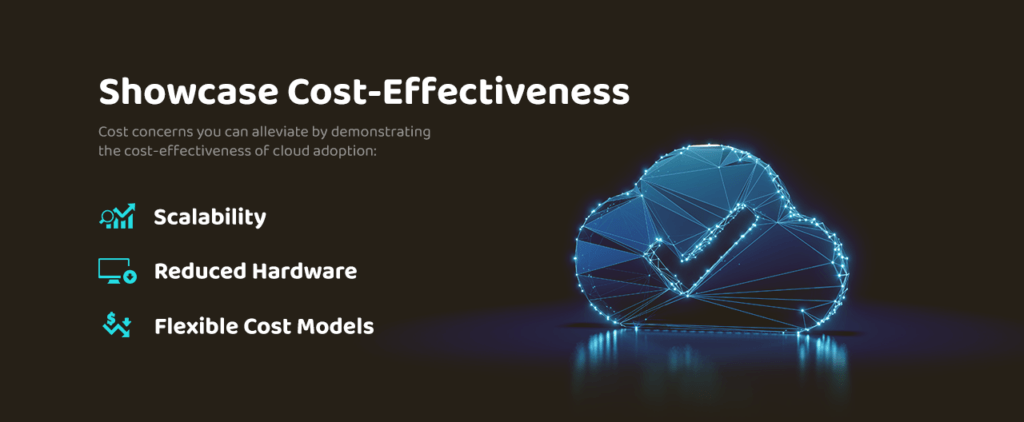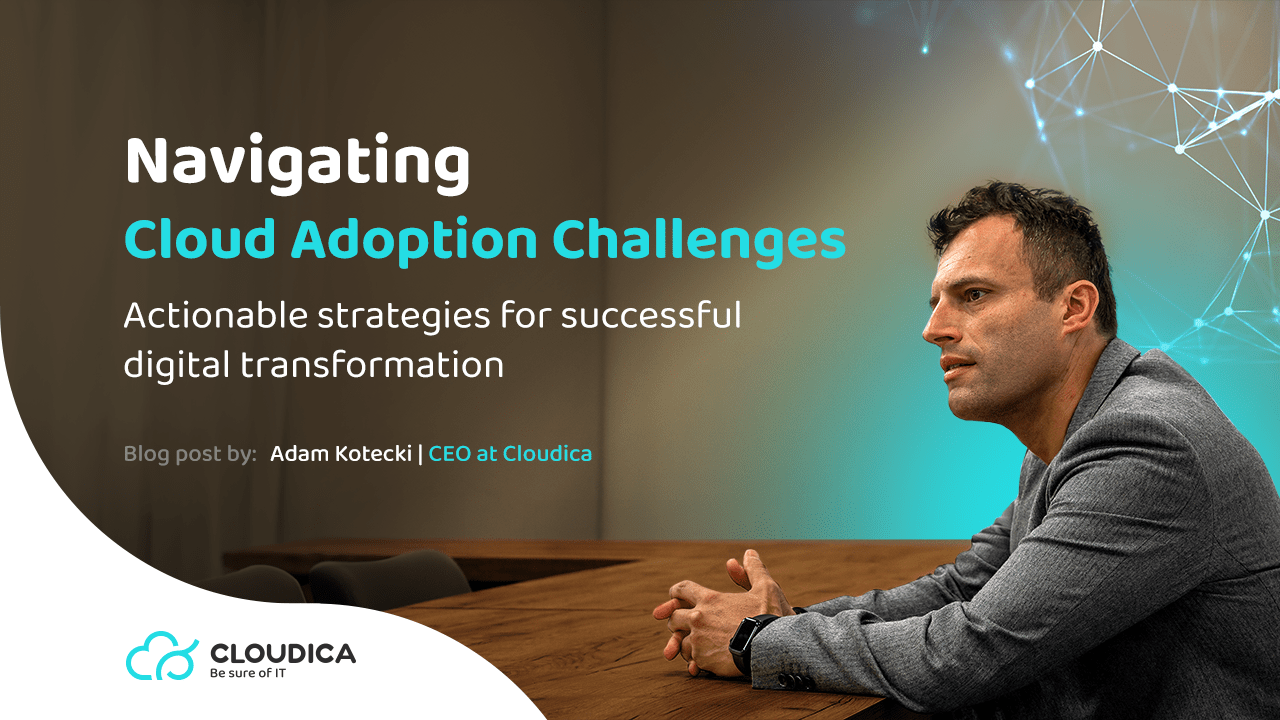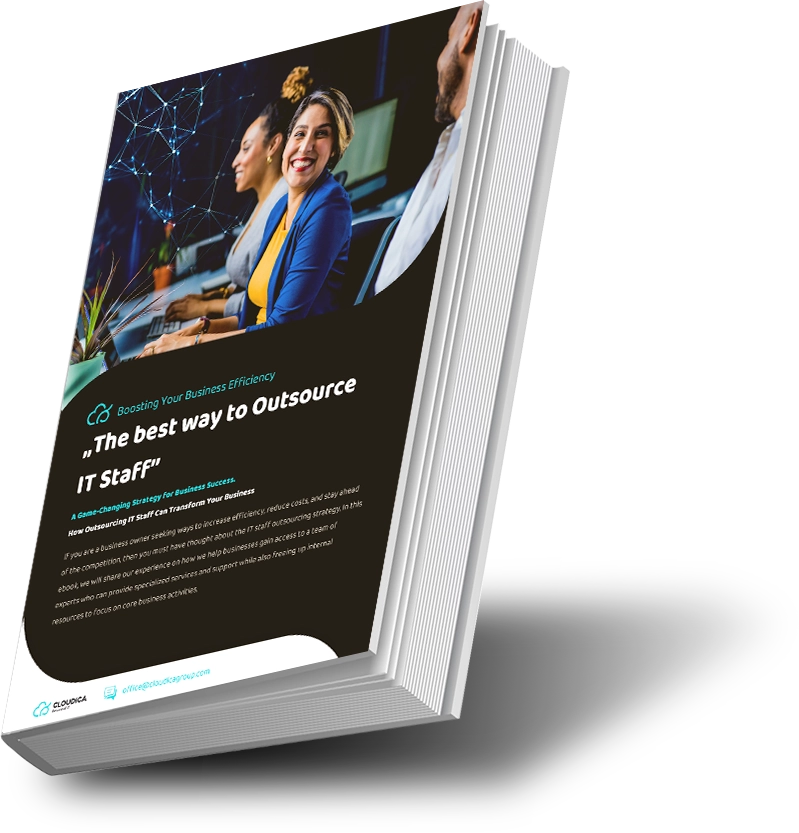Digital transformation has become a crucial factor in determining the success and growth of businesses, regardless of their size. For small and medium-sized enterprises (SMEs), embracing the power of the cloud can be a game-changer in achieving operational efficiency, cost-effectiveness, and staying competitive in the digital age. However, despite the numerous benefits of cloud adoption, many SMEs face resistance when it comes to transitioning their operations to the cloud.
In this article, I will explore common challenges SMEs encounter and provide strategies to overcome resistance, ensuring that you can have a smooth and successful digital transformation journey.
Where is the Resistance? And Why?
Before devising strategies to overcome resistance, it is essential to identify the root causes. Small and medium-sized enterprises often face common concerns, that fall under one of four areas:
- Security which is a top priority for any business. SMEs might fear data breaches, loss of control over sensitive information, and lack of trust in cloud service providers.
- Cost – budget constraints can lead to apprehensions regarding the affordability of cloud services and potential hidden costs associated with migration and training.
- Data Control might be a huge constraint as some SMEs are hesitant to relinquish control over their data and applications to third-party cloud providers.
- Complexity of cloud migration and integration can be perceived as complex and time-consuming, raising concerns about potential disruptions to ongoing operations.
Here are a bunch of common worries from our customers:
Sarah, Head of Operations, Production Company “I’ve heard about the benefits of the cloud, but I’m concerned about how it will affect our day-to-day operations. Will it disrupt our workflow and the processes we have in place?”
Michael, IT Manager, Software House: “Security is a top priority for us. I’m worried about the safety of our client data and intellectual property in the cloud. We need reassurance that our sensitive information will be protected.”
Emily, Lead Developer, Pharmaceutical industry: “Migrating our applications to the cloud sounds complex. I’m not sure if our current team has the expertise to handle the technical challenges that come with such a significant change.”
David, Founder & CEO, Recruitment Agency: “As excited as I am about the cloud’s potential, I understand the team’s concerns. We need to carefully consider all aspects of cloud transformation and ensure a smooth transition for our business.”
To address this kind of resistance effectively, you need a clear and well-defined cloud adoption strategy adjusted to the customer’s business specifics.
Clear Cloud Adoption Strategy – Show them how it will work

From my perspective, a successful cloud adoption strategy should be created with consideration of 4 main rules that touch all business areas: Comprehensive Assessment, Prioritization, Step-by-step Approach and Training and Support.
- Comprehensive Assessment – conduct a thorough evaluation of the organization’s current infrastructure, applications, and data to identify areas that can benefit most from the cloud.
- Prioritization – prioritize cloud migration based on business needs and potential impact. Start with non-critical applications to build confidence and experience.
- Step-by-step Approach – break the transformation process into manageable phases to minimize disruptions and allow employees to adapt gradually.
- Training and Support – provide comprehensive training and ongoing support to employees to ensure they are comfortable with the new cloud environment.
Address Security Concerns
Security is a significant concern for companies contemplating cloud adoption. By adopting the recommendations presented below, you can strengthen your cloud security posture, protect sensitive data, and foster trust with customers and stakeholders. Proactive security measures are essential to safeguard against evolving cyber threats in the digital landscape.
Consider also choosing reputable CSPs with robust security measures, compliance certifications, and a track record of reliable service. Ensure that data is encrypted both during transmission and storage to prevent unauthorized access. Implement strong access controls and multi-factor authentication to safeguard sensitive information. Choose CSPs and Cloud Vendor that comply with relevant data protection regulations and industry standards.
To address security concerns effectively, consider implementing the following recommendations based on best practices from our experience:
Implement Robust Data Encryption: Ensure that all customer data, including personal information and payment details, are encrypted both during transit and at rest in the cloud. Robust encryption protocols provide an extra layer of protection against unauthorized access to sensitive data.
Enforce Secure Access Controls: Implement stringent access controls that limit data access to authorized personnel on a need-to-know basis. Enforcing multi-factor authentication (MFA) for critical systems and databases reduces the risk of unauthorized access.
Adopt Continuous Threat Monitoring: Employ advanced security monitoring tools that continuously scan for potential threats and anomalies in the cloud environment. Real-time alerts enable swift response to any suspicious activities.
Conduct Regular Security Audits: Perform frequent security audits and vulnerability assessments to identify and address potential weaknesses in the cloud infrastructure proactively. This approach ensures a strong defense against cyber threats.
Ensure Compliance with Industry Regulations: Adhere to industry-specific data protection regulations and standards in your cloud adoption strategy. Compliance with relevant laws and guidelines ensures the highest standards of data privacy and security.
Invest in Employee Security Training: Provide comprehensive security training for all employees to educate them about cybersecurity importance and best practices for data protection. Employees trained to recognize and report potential security threats can significantly enhance the overall security posture.
Develop an Incident Response Plan: Create a detailed incident response plan to handle security breaches and data incidents effectively. The plan should include predefined protocols for notifying affected parties, containing the breach, and initiating recovery measures.
Utilize Secure Payment Processing: Partner with trusted payment gateways to process customer transactions securely. Utilizing encrypted payment channels ensures that sensitive financial information remains protected during online transactions.
Keep Software Up-to-Date: Ensure that the IT team promptly installs security patches and updates for all cloud-based applications and systems. Keeping software up to date minimizes the risk of exploitation by patching vulnerabilities.
Choose Reliable Security Partnerships: Collaborate with reputable cloud service providers that prioritize security and data protection. Selecting reliable partners grants access to cutting-edge security measures and expertise.
Showcase Cost-Effectiveness
By showcasing cost-effectiveness through reports, dashboards, case studies, ROI analyses, and infographics, concrete evidence of the financial benefits of cloud adoption can be provided. Demonstrating cost savings and efficiency gains not only justifies cloud investments but also encourages a cost-conscious and data-driven approach to cloud management.

Cost concerns you can alleviate by demonstrating the cost-effectiveness of cloud adoption:
- Scalability
Emphasize the ability to scale cloud resources based on demand, allowing SMEs to pay for what they use, and avoiding unnecessary expenses.
- Reduced Hardware Costs
Point out the potential savings on hardware investments and maintenance costs with cloud-based solutions.
- Flexible Cost Models
Highlight the flexibility of CSP pricing, which allows SMEs to adjust their expenses according to actual usage.
Discover how our customers showcase cloud cost-effectiveness through real-world examples:
IT services firm: To demonstrate the cost-effectiveness of their cloud adoption, the company prepared a detailed cloud cost optimization report. It highlighted significant savings achieved by eliminating on-premises servers and adopting the pay-as-you-go pricing model. The report showcased improved resource allocation efficiency and reduced operational expenses. By providing clear before-and-after cost comparisons, the company provided concrete evidence of the financial benefits of their cloud transformation.
Online retailer: Seeking to prove the cost-effectiveness of their cloud infrastructure, the company implemented a real-time cost dashboard. This dashboard allowed them to track current cloud usage and associated expenses, empowering department heads and management to make data-driven decisions. Identifying areas for cost optimization, like rightsizing instances and managing idle resources, led to substantial cost savings over time.
Renewable energy company: Company X illustrated the financial benefits of their cloud adoption through a cost comparison case study. It demonstrated the lower total cost of ownership (TCO) of their cloud-based solution compared to traditional on-premises alternatives. By showcasing reduced upfront investment, lower maintenance costs, and scalability advantages, they attracted new clients looking for budget-friendly solutions.
Travel agency: To justify its cloud migration cost, the company conducted a thorough return on investment (ROI) analysis. This analysis compared migration expenses to long-term benefits, emphasizing reduced hardware and maintenance costs, operational efficiency, and revenue improvement through enhanced website performance and reduced downtime. The ROI analysis gained support from the finance department for future cloud initiatives.
By learning from these examples, you can leverage real-world strategies to showcase the value of cloud cost-effectiveness, fostering support and confidence in your cloud initiatives.
Maintain Data Control and Ownership
By implementing various security measures like data encryption, access controls, on-premises data backup, and private cloud deployment, along with adhering to data residency compliance and establishing strong contractual agreements with cloud providers, companies can effectively maintain control and ownership of their data in the cloud environment. These practices ensure that sensitive data remains secure and accessible only to authorized personnel, while non-sensitive data can be leveraged for scalable processing and improved business operations. Such control and ownership are crucial for businesses as they help safeguard intellectual property, build and maintain customer trust, and comply with data privacy regulations.
To address concerns about data control, there are several key areas to focus on. Firstly, ensuring robust data backup and recovery solutions are offered by the cloud provider is essential. This way, SMEs can maintain control over their critical data even in the event of unforeseen data loss incidents. Secondly, establishing clear contractual agreements with the cloud provider is crucial, outlining data ownership and access rights to avoid any ambiguity. Lastly, considering hybrid solutions can be advantageous for SMEs, allowing them to retain sensitive data on-premises while utilizing the cloud for less sensitive applications, striking a balance between security and flexibility. By prioritizing these aspects, businesses can confidently embrace the cloud while maintaining control over their valuable data.
Here are some real-world examples that highlight the value of addressing data control and ownership issues in different industries:
Financial Institution: A financial institution takes data control seriously, especially when handling sensitive customer information in the cloud. They prioritize data security by implementing robust data encryption during data transit and storage. Strict access controls ensure that only authorized personnel can access sensitive data, preventing unauthorized access or data breaches. This approach instills confidence in their customers, knowing their data is in safe hands.
Pharmaceutical Company: A pharmaceutical company adopts a hybrid cloud strategy to maintain control over critical research and development data. By keeping sensitive data on-premises and leveraging the cloud for non-sensitive data processing, they safeguard their valuable intellectual property. This strategy allows them to balance data control and scalability effectively.
Technology Firm: To ensure maximum data control and ownership, a technology firm opts for a private cloud deployment. Hosting their cloud infrastructure on dedicated servers gives them exclusive access to their proprietary software and client data. This level of control enhances data management and fortifies its defence against potential data breaches.
Global Logistics Company: Operating in various countries with different data residency requirements, a logistics company employs multi-region cloud storage. This allows them to store and process data within specific regions, complying with local regulations while maintaining data control and security. Such a solution assures their clients of data protection and adherence to the law.
Media and Entertainment Company: A media and entertainment company secures their data control by establishing clear contractual agreements with its cloud service providers. These agreements explicitly state that the company retains full ownership and control of their data. The contracts also outline the responsibilities of the cloud providers regarding data security, backups, and compliance, providing the company with peace of mind and control over its valuable assets.
By learning from these examples and implementing similar strategies, you can ensure data control and ownership, protect sensitive information, and maintain trust with your customers and clients. Prioritizing data security and ownership ultimately leads to improved business operations and resilience in today’s digital landscape.
Simplify the Migration Process
By creating a clear migration roadmap, utilizing automated migration tools, conducting cloud readiness assessments, performing POC projects, leveraging cloud vendor support, investing in training, and forming migration partnerships, companies can simplify the migration process significantly. These strategies ensure a well-structured and efficient transition to the cloud, minimizing disruptions, reducing complexity, and maximizing the benefits of cloud adoption.
SMEs may be hesitant due to the perceived complexity of cloud migration so simplification of the process is critical. Seek Expert Assistance and engage an experienced cloud migration partner to guide the organization through the migration process smoothly. Start with small, low-risk pilot projects to gain hands-on experience before moving on to more extensive migrations. Involve employees in the decision-making process and encourage their participation in the migration plan.
You can do this

Overcoming resistance to cloud adoption is a critical step for SMEs in achieving successful digital transformation. We have seen it many times but by developing a clear strategy, addressing security concerns, showcasing cost-effectiveness, maintaining data control, and simplifying the migration process, you can embrace the cloud with confidence. By doing so, you can benefit from the full potential of digital transformation, improving efficiency, customer experiences, and overall competitiveness in today’s dynamic business landscape.


